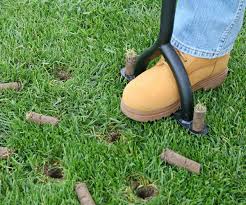 Things starting to get tight below the green? Grass roots struggling? Time to aerate! Says Metcalf intern Leah Garner.
Things starting to get tight below the green? Grass roots struggling? Time to aerate! Says Metcalf intern Leah Garner.
Below the ground a worm struggles, trapped in the layers of tightly packed organic matter and soil of your lawn. Each new footstep smashes in an opening where the worm can execute its day to day activities. Your turf’s roots suffer without the worm adding to soil structure, cycling nutrients and breaking down organic matter.
This fall, end the suffering and aerate! By perforating the soil with holes, aeration provides fresh air, water and nutrients to grass roots and the entire soil ecosystem. This freshness combats compacted soil that restrict air access, growth ability, and water uptake capacity of most living organisms including your turf’s roots.
With more area to work, your turf’s roots can increase its mass and uptake more nutrients and water. Stronger, thicker and healthier root systems develop superior resistance to weeds, diseases, pests and environmental stresses of droughts and long winters.
Aeration holes, also, break up the layers of dead and living organic matter above the soil surface called thatch (see this graphic). By accumulating underground grass stems (rhizomes) and aboveground stems (stolons), thatch may harbor pests, diseases and unfavorable conditions for root uptake of air, water, and nutrients.
You do not need the expertise of a soil scientist nor the life experience of a constricted worm to tell when to aerate your soil. Find your toolbox, pick up a screwdriver and push it through your lawn’s soil. Having any difficulty pushing it down? Then you likely have compacted soil.
For thatch, grab a pocketknife to cut a triangular section of turf three inches long and two inches deep. You should find a thatch layer of brown roots and stem tissues in between the green turf leaves and the soil. If that layer exceeds one inch in thickness, it could provide prime conditions for pests and diseases.
When aerating, you want to address both the compacted soil and the thick thatch layer. Spikers and slicers that poke narrow holes in the soil without removing cores offer only a temporary solution to these problems and may further compact your soil.
For most effective results, visit your local hardware store and search for a hollow core aerator type, either a man-powered hand aerifier or a machine-driven piston-type aerifier. These aerators should remove soil cores 1/4 – 1/2 inches in diameter and reach 3 to 4 inches deep. Aerate the soil at 4 – 6 inches apart and leave the cores on the lawn to dry for 1 – 2 days. Once dry, mow over the cores to break them up and return nutrients to the soil, like our earthworm friend!
Aeration works best at two times over the year: In mid- to late- spring (May 1 to June 15) and early fall (September 1 to 30)! Fall aeration builds strong and large turf root systems to outlast the winter and trigger stem growth at the start of spring.
Many more practices this fall will help your grass spruce up next spring. For additional lawn care tips, refer to our In Your Home Page.
